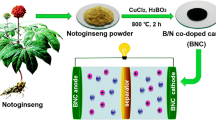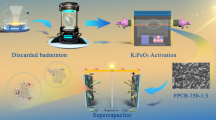Abstract
Porous graphitic carbon materials (PGCs) with a microtubular structure were synthesized by a simple method simultaneously completing graphitization and activation for the mixture of willow catkins, KCl, and different ferric salts. The introduction of KCl was crucial to develop a porous structure. KCl, replacing corrosive KOH or poisonous ZnCl2, greatly decreased the cost for production of PGCs. The resulting material PGCN, which was produced by willow catkins, KCl, and Fe(NO3)3, not only inherited the natural microtubular morphology of willow catkins but also possessed a high graphitization degree and abundant porosity. As such, PGCN could serve as an ideal substrate for MnO2 deposition to alleviate its accumulation and improve its conductivity. The obtained PGCN/MnO2 composite electrode significantly enhanced high specific capacitance 571.1 F g− 1 at 2 A g− 1 based on the mass of MnO2. Even at a high current density of 50 A g− 1, specific capacitance still reached 382.1 F g− 1. Furthermore, the electrode exhibited outstanding cycling stability with only 14.8% degradation after 3000 cycles. This study proposes a novel graphitization–activation way for synthesis of porous graphitic carbon by utilizing biomass waste to alleviate the dependence on non-renewable sources.
Graphical Abstract
Schematic diagram of porous graphitic carbon by carbonizing the mixture of willow catkins, Fe(NO3)3, and KCl. The obtained PGCN which inherited the natural microtubular morphology of willow catkins had high graphitized and porous structure.










Similar content being viewed by others
References
Titirici MM, White RJ, Brun N, Budarin VL, Su DS, del Monte F, Clark JH, MacLachlan MJ (2015) Sustainable carbon materials. Chem Soc Rev 44:250–290
Zhu Y, Murali S, Stoller MD, Ganesh KJ, Cai W, Ferreira PJ, Adam P, Wallace RM, Cychosz KA, Thommes M, Su D, Stach EA, Ruoff RS (2011) Carbon-based supercapacitors produced by activation of graphene. Science 332:1537–1541
Akbulut S, Yilmaz M, Raina S, Hsu SH, Kang WP (2017) Advanced supercapacitor prototype using nanostructured double-sided MnO2/CNT electrodes on flexible graphite foil. J Appl Electrochem 47:1035–1044
Wang G, Xu H, Lu L, Zhao H, Tian Y, An W (2016) High-voltage asymmetric supercapacitor based on MnO2 nanotubes//active carbon-multiwalled carbon nanotubes. J Appl Electrochem 46:1091–1097
Hu L, Chen W, Xie X, Liu N, Yang Y, Wu H, Yao Y, Pasta M, Alshareef HN, Cui Y (2011) Symmetrical MnO2–carbon nanotube–textile nanostructures for wearable pseudocapacitors with high mass loading. ACS Nano 5:8904–8913
Yu G, Hu L, Liu N, Wang H, Vosgueritchian M, Yang Y, Cui Y, Bao Z (2011) Enhancing the supercapacitor performance of graphene/MnO2 nanostructured electrodes by conductive wrapping. Nano Lett 11:4438–4442
Zhao J, Jiang Y, Fan H, Liu M, Zhuo O, Wang X, Wu Q, Yang L, Ma Y, Hu Z (2017) Porous 3D few-layer graphene-like carbon for ultrahigh-power supercapacitors with well-defined structure-performance relationship. Adv Mater:1604569
Sun L, Tian C, Wang L, Zou J, Mu G, Fu H (2011) Magnetically separable porous graphitic carbon with large surface area as excellent adsorbents for metal ions and dye. J Mater Chem 21:7232–7239
Bon YS, Seok CG, Soon KK, Jong-Sung Yu, Kamil G, Mietek J (2005) Graphitized pitch-based carbons with ordered nanopores synthesized by using colloidal crystals as templates. J Am Chem Soc 127:4188–4189
Wang L, Tian C, Wang H, Ma Y, Wang B, Fu H (2010) Mass production of graphene via an in situ self-generating template route and its promoted activity as electrocatalytic support for methanol electroxidization. J Phys Chem 114:8727–8733
Gu W, Hu L, Li J, Wang E (2016) Iron and nitrogen co-doped hierarchical porous graphitic carbon for a high-efficiency oxygen reduction reaction in a wide range of pH. J Mater Chem A 4:14364–14370
Sevilla M, Fuertes AB (2010) Graphitic carbon nanostructures from cellulose. Chem Phys Lett 490:63–68
Liu Y, Liu Q, Gu J, Kang D, Zhou F, Zhang W, Wu Y, Zhang D (2013) Highly porous graphitic materials prepared by catalytic graphitization. Carbon 64:132–140
Zhai D, Du H, Li B, Zhu Y, Kang F (2011) Porous graphitic carbons prepared by combining chemical activation with catalytic graphitization. Carbon 49:725–729
Chen L, Ji T, Mu L, Zhu J (2017) Cotton fabric derived hierarchically porous carbon and nitrogen doping for sustainable capacitor electrode. Carbon 111:839–848
Sevilla M, Mokaya R (2014) Energy storage applications of activated carbons: supercapacitors and hydrogen storage. Energy Environ Sci 7:1250–1280
Ma Y, Zhao J, Zhang L, Zhao Y, Fan Q, Li X, Hu Z, Huang W (2011) The production of carbon microtubes by the carbonization of catkins and their use in the oxygen reduction reaction. Carbon 49:5292–5297
Zhang X, Zhang K, Li H, Cao Q, Jin L, Li P (2017) Porous graphitic carbon microtubes derived from willow catkins as a substrate of MnO2 for supercapacitors. J Power Sources 344:176–184
Hu L, Pasta M, Mantia FL, Cui L, Jeong S, Deshazer HD, Choi JW, Han SM, Cui Y (2010) Stretchable, porous, and conductive energy textiles. Nano Lett 10:708–714
He X, Zhao N, Qiu J, Xiao N, Yu M, Yu C, Zhang X, Zheng M (2013) Synthesis of hierarchical porous carbons for super capacitors from coal tar pitch with nano-Fe2O3 as template and activation agent coupled with KOH activation. J Mater Chem A 1:9440–9448
Wang L, Mu G, Tian C, Sun L, Zhou W, Yu P, Yin J, Fu H (2013) Porous graphitic carbon nanosheets derived from cornstalk biomass for advanced supercapacitors. ChemSusChem 6:880–889
Xie L, Sun G, Su F, Guo X, Kong Q, Li X, Huang X, Wan L, song W, Li K, Lv C, Chen CM (2016) Hierarchical porous carbon microtubes derived from willow catkins for supercapacitor applications. J Mater Chem A 4:1637–1646
Liu T, Liu E, Ding R, Luo Z, Hu T, Li Z (2015) Preparation and supercapacitive performance of clew-like porous nanocarbons derived from sucrose by catalytic graphitization. Electrochim Acta 173:50–58
Moon IK, Lee J, Ruoff RS, Lee H (2010) Reduced graphene oxide by chemical graphitization. Nat Commun 1:1–6
Ma F, Ma D, Wu G, Geng W, Shao J, Song S, Wan J, Qiu J (2016) Construction of 3D nanostructure hierarchical porous graphitic carbons by charge-induced self-assembly and nanocrystal-assisted catalytic graphitization for supercapacitors. Chem Commun 52:6673–6676
Yorgun S, Vural N, Demiral H (2009) Preparation of high-surface area activated carbons from Paulownia wood by ZnCl2 activation. Micropor Mesopor Mat 122:189–194
Hou J, Cao C, Idrees F, Ma X (2015) Hierarchical porous nitrogen-doped carbon nanosheets derived from silk for ultrahigh-capacity battery anodes and supercapacitors. ACS nano 9:2556–2564
Chang B, Guo Y, Li Y, Yin H, Zhang S, Yang B, Dong X (2015) Graphitized hierarchical porous carbon nanospheres: simultaneous activation/graphitization and superior supercapacitance performance. J Mater Chem A 3:9565–9577
Song H, Yang G, Wang C (2014) General scalable strategy toward heterogeneously doped hierarchical porous graphitic carbon bubbles for lithium-ion battery anodes. ACS Appl Mater Interfaces 6:21661–21668
Gutiérrez-Pardo A, Ramírez-Rico J, Cabezas-Rodríguez R, Martínez-Fernández J (2015) Effect of catalytic graphitization on the electrochemical behavior of wood derived carbons for use in supercapacitors. J Power Sources 278:18–26
Lei Z, Zhang J, Zhao XS (2012) Ultrathin MnO2 nanofibers grown on graphitic carbon spheres as high-performance asymmetric supercapacitor electrodes. J Mater Chem 22:153–160
Xing Z, Ju Z, Zhao Y, Wan J, Zhu Y, Qiang Y, Qian Y (2016) One-pot hydrothermal synthesis of Nitrogen-doped graphene as high-performance anode materials for lithium ion batteries. Sci Rep 6
Yadav R, Dixit CK (2017) Synthesis, characterization and prospective applications of nitrogen-doped graphene: a short review. J Sci Adv Mater Device 2:141–149
Toupin M, Brousse T, Bélanger D (2004) Charge storage mechanism of MnO2 electrode used in aqueous electrochemical capacitor. Chem Mater 16:3184–3190
Kundu M, Liu L (2013) Direct growth of mesoporous MnO2 nanosheet arrays on nickel foam current collectors for high-performance pseudocapacitors. J Power Sources 243:676–681
Chen LF, Huang ZH, Liang HW, Guan QF, Yu SH (2013) Bacterial-cellulose-derived carbon nanofiber@MnO2 and nitrogen-doped carbon nanofiber electrode materials: an asymmetric supercapacitor with high energy and power density. Adv Mater 25:4746–4752
An J, Liu J, Ma Y, Li R, Li M, Li MYS (2012) Fabrication of graphene/polypyrrole nanotube/MnO2 nanotube composite and its supercapacitor application. Eur Phys J Appl Phys 58:30403
Dong X, Wang X, Wang J, Song H, Li X, Wang L, Chan-Park MB, Li CM, Chen P (2012) Synthesis of a MnO2-graphene foam hybrid with controlled MnO2 particle shape and its use as a supercapacitor electrode. Carbon 50:4865–4870
Kong S, Cheng K, Ouyang T, Gao Y, Ye K, Wang G, Cao D (2017) Facile dip coating processed 3D MnO2-graphene nanosheets/MWNT-Ni foam composites for electrochemical supercapacitors. Electrochim Acta 226:29–39
Shin HC, Dong J, Liu M (2003) Nanoporous structures prepared by an electrochemical deposition process. Adv Mater 15:1610–1614
Yuan C, Zhang X, Su L, Gao B, Shen L (2009) Facile synthesis and self-assembly of hierarchical porous NiO nano/micro spherical superstructures for high performance supercapacitors. J Mater Chem 19:5772
Antiohos D, Pingmuang K, Romano MS, Beirne S, Romeo T, Aitchison P, Minett A, Wallace G, Phanichphant S, Chen J (2013) Manganosite–microwave exfoliated graphene oxide composites for asymmetric supercapacitor device applications. Electrochim Acta 101:99–108
Wang H, Hao Q, Yang X, Lu L, Wang X (2010) A nanostructured graphene/polyaniline hybrid material for supercapacitors. Nanoscale 2:2164–2170
Liu J, Zhang Y, Li Y, Li J, Chen Z, Feng H, Li J, Jiang J, Qian D (2015) In situ chemical synthesis of sandwich-structured MnO2/graphene nanoflowers and their supercapacitive behavior. Electrochim Acta 173:148–155
Zhang J, Jiang J, Zhao XS (2011) Synthesis and capacitive properties of manganese oxide nanosheets dispersed on functionalized graphene sheets. J Phys Chems 115(14):6448–6454
Xiong C, Li T, Dang A, Zhao T, Li H, Lv H (2016) Two-step approach of fabrication of three-dimensional MnO2–graphene–carbon nanotube hybrid as a binder-free supercapacitor electrode. J Power Sources 306:602–610
Wu D, Xu S, Li M, Zhang C, Zhu Y, Xu Y, Zhang W, Huang R, Qi R, Wang L, Chu PK (2015) Hybrid MnO2/C nano-composites on a macroporous electrically conductive network for supercapacitor electrodes. J Mater Chem A 3:16695–16707
Acknowledgements
All the authors are very grateful for the financial support of the National Natural Science Foundation of China NSFC (No. 51174144).
Author information
Authors and Affiliations
Corresponding author
Rights and permissions
About this article
Cite this article
Zhang, X., Zhang, K., Li, H. et al. Synthesis of porous graphitic carbon from biomass by one-step method And its role in the electrode for supercapacitor. J Appl Electrochem 48, 415–426 (2018). https://doi.org/10.1007/s10800-018-1170-x
Received:
Accepted:
Published:
Issue Date:
DOI: https://doi.org/10.1007/s10800-018-1170-x




